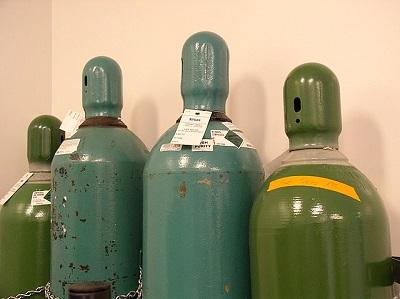Introduction: What are Compressed Gas Cylinders and Why are They Important?
Compress gas cylinders are cylindrical in shape and are typically made of steel, aluminum, or stainless steel. They are primarily used to store gases under pressure for use in various applications. They are used as part of welding systems, in manufacturing, maintenance, refrigeration, medical procedures, and even lab experiments.
Common Cylinder Contents
– Inert gases: (ex. Nitrogen, Helium) are neither flammable nor toxic. However, if a large amount of inert gas is accidentally released into a poorly ventilated room or confined space, the otherwise harmless gas will displace oxygen-containing air – This will result in a dangerously low oxygen atmosphere which may lead to unconsciousness and even death!
– Flammable – if a leaking or broken cylinder contains a flammable gas such as Hydrogen, Methane, or Propane:
- Normal air will also be displaced.
- Even more dangerous, clouds of flammable gases ignite easily and burn explosively
- Leaking hose connections, faulty valves, and ruptured cylinders can release flammable gases that can accumulate in confined spaces
- Electrical outlets, switches, open flames, and other ignition sources can easily ignite these clouds
– Oxygen: Oxygen is a common compressed gas that is not directly flammable or toxic – nonetheless, an excess of oxygen in an enclosed area presents a danger.
- Because oxygen is such a powerful oxidizer, it increases any combustible materials ability to burn
- Fires in an oxygen-enriched atmosphere will begin easily and burn faster and more intensely than in normal air
- For this reason, in a pure oxygen system, even grease and oil in fittings and regulators must be avoided in order to prevent their combustion
– Toxic gases: High-pressure gas cylinders that contain an inherently toxic gas present the greatest danger. Accidental exposure to a released toxic gas presents an immediate hazard. Gases such as ammonia or chlorine will quickly attack and burn the eyes and sensitive nose and lung tissue To prevent exposure, extra care should be taken to be sure all toxic gas hose connections and valves are sealed and operating properly.
– Unexpectedly released toxic gases:
- Can disperse more quickly than expected, leaving little time for anyone to react.
- Low concentrations can harm personnel
- Common gases like carbon monoxide can be flammable and toxic in certain situations
How to Keep Yourself Safe at Work When Working with Compressed Gases
As a compressed gas worker, you need to know how to keep yourself safe on the job. If you have a gas cylinder in your possession, the following safety measures must be observed:
Special precautions are required to safely store cylinders that contain flammable gases and oxidizers
- To reduce the risk of fire they must be kept away from live electrical equipment, open flames, or any other potential sources of ignition. Do not smoke near the cylinders.
- Keep cylinders away from heat or flames. Flammable gases should also be separated from oxidizers, either by a wall or a distance of at least 20 feet.
Compressed gas cylinders make it simpler to work with gases, but the cylinders themselves need to be handled with care.
First, whenever you move a cylinder, even over a short distance, make sure its “safety cap” is on.
- This cap protects the cylinder’s valve in the event of a bump or fall.
- It should always be in place when a cylinder is being transported… and whenever it’s not being used as well.
Never drag a cylinder across the floor.
- This can damage the walls of the cylinder, especially at the base.
- If the base becomes uneven, the cylinder will be unstable when it’s set upright.
An unstable cylinder is more likely to fall, and cause damage to its valve or other cylinders nearby.
- It can also cause leaks in any gas lines it’s connected to.
Don’t “hand roll” cylinders for anything more than a few feet, either.
- They’re hard to control when you do this, and dropping a cylinder is very dangerous.
But if a compressed gas cylinder starts to fall, don’t try to catch it!
- More people are injured by trying to catch heavy, falling cylinders than by any other compressed gas hazard.
- Always wear safety shoes with steel toes when you’re handling cylinders.
- That way if one does fall, your toes will at least stay intact!
The safest way to move compressed gas cylinders is with a “cylinder hand truck”.
- These have curved braces that cradle a cylinder, and chains or straps to secure it in place.
When moving cylinders between floors, use service elevators or dumbwaiters.
- But riding along with a cylinder in an elevator is not a good idea.
- Until the door opens at your destination, you’re stuck, in a very small space, and a leaking cylinder can quickly foul the air inside.
- So walk up the stairs to meet the cylinder when it arrives, or have someone else positioned there to receive it.
—
If you’d like to view a free demonstration online Compressed Gas Cylinders Safety training, sign up for a free demonstration.










